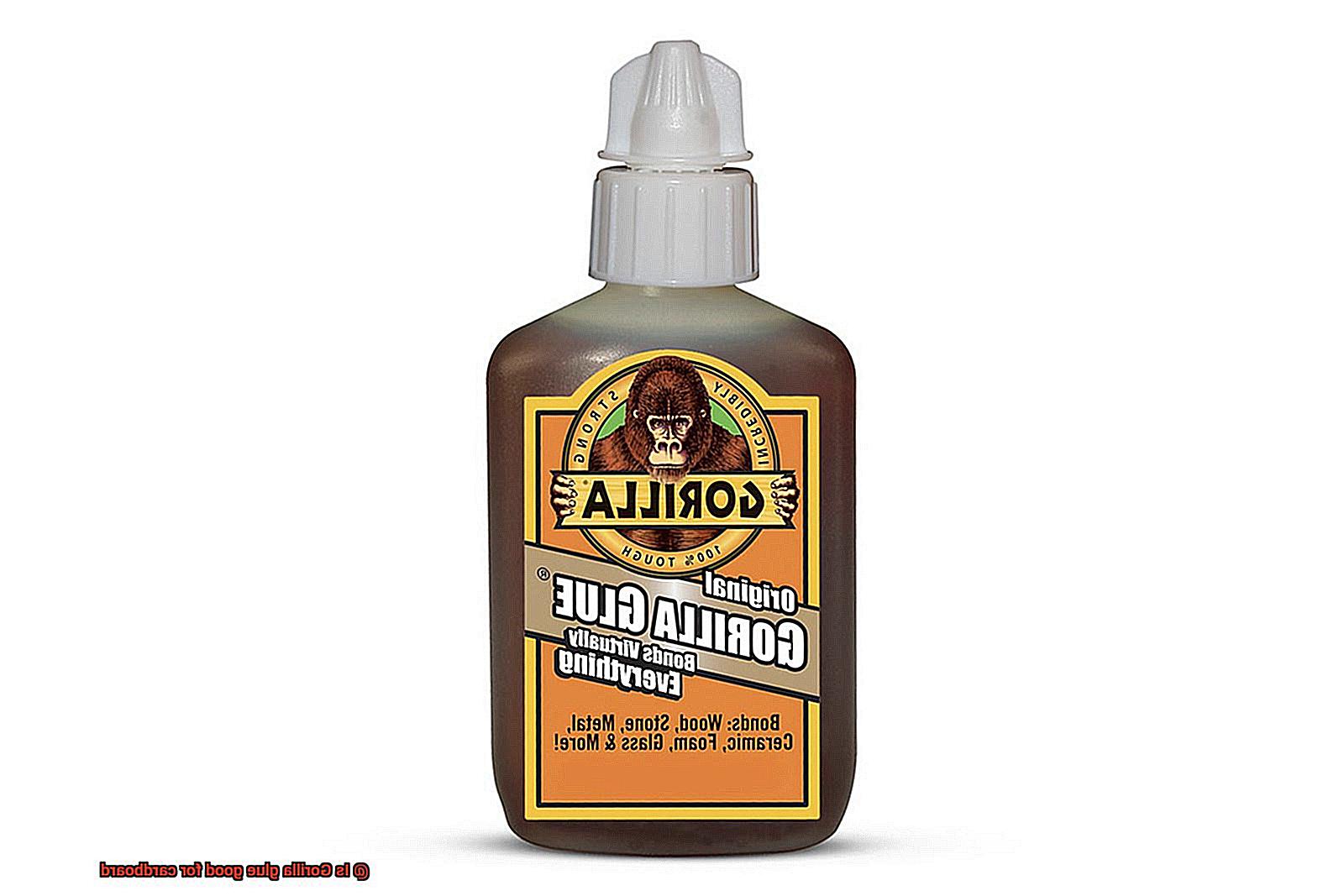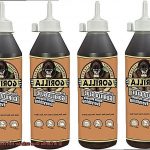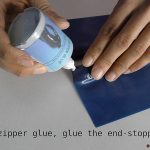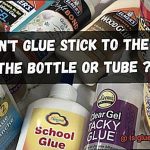Are you tired of weak cardboard projects that fall apart with the slightest touch?
Well, worry no more because I’ve got the perfect solution for you. Gorilla Glue, the ultimate adhesive for all your fixing needs, is not only great for bonding different materials but also works like magic on cardboard.
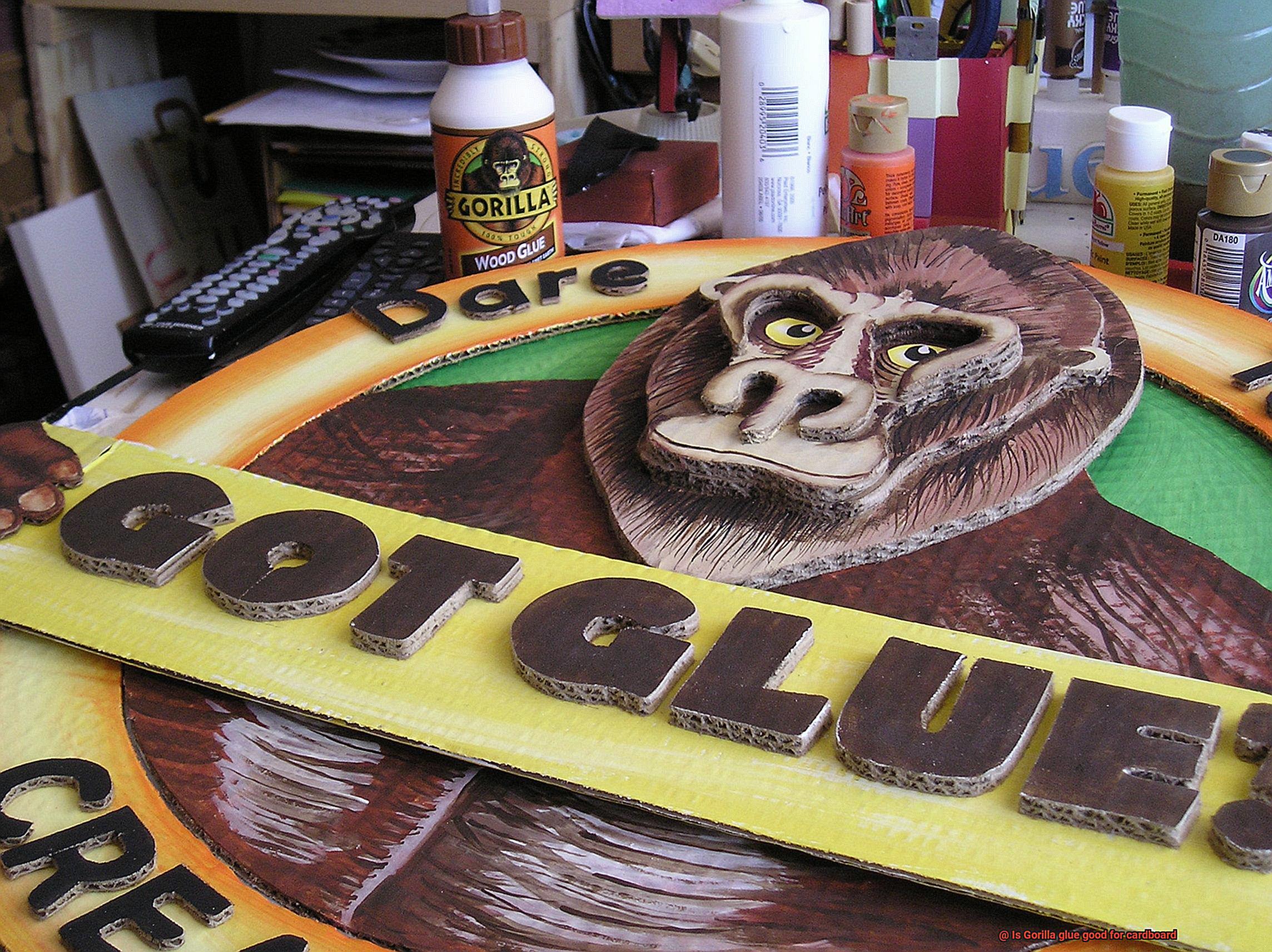
Yes, you heard it right. Gorilla Glue is a total game-changer when it comes to working with this versatile material.
Whether you’re making a costume, building a model, or creating a prototype, Gorilla Glue will make sure your cardboard projects last forever. In this blog post, we’ll dive into all the amazing benefits of using Gorilla Glue on cardboard.
So grab a seat and prepare to take your crafting skills to a whole new level.
What is Gorilla Glue?
Contents
- 1 What is Gorilla Glue?
- 2 What is Cardboard?
- 3 How Does Gorilla Glue Bond with Cardboard?
- 4 Different Types of Gorilla Glue and Their Suitability for Cardboard
- 5 Preparing the Surface for Gorilla Glue Application on Cardboard
- 6 Using Gorilla Glue on Cardboard
- 7 Potential Expansion of Gorilla Glue When Used on Cardboard
- 8 Testing the Adhesive Before Applying to the Entire Project
- 9 Conclusion
Gorilla Glue is not your average adhesive. It is a polyurethane-based wonder that first hit the market in the late 1990s and quickly became a go-to choice for bonding projects. This adhesive has gained a well-deserved reputation for its exceptional strength and versatility.
What sets Gorilla Glue apart is its ability to create incredibly strong bonds on a wide range of materials. Whether you’re working with wood, metal, stone, ceramics, glass, or many types of plastics, Gorilla Glue will hold them together with unwavering grip.
However, when it comes to cardboard, things get a bit trickier. Cardboard is a lightweight and porous material that readily absorbs moisture. And here lies the potential problem. Gorilla Glue’s composition involves expanding into the material it bonds with, thanks to moisture absorption from the air or the surface itself. While this expansion is perfect for many materials, it may not be ideal for cardboard.
When Gorilla Glue meets cardboard, there’s a risk of excessive moisture absorption. This can lead to warped or weakened cardboard, which is far from desirable. Furthermore, the expanding nature of the glue might create unsightly bulges or uneven surfaces on the cardboard.
Another aspect to consider is drying time. Gorilla Glue requires moisture to cure properly and reach its maximum strength. In humid environments or when applied to materials with high moisture content like cardboard, drying time can be extended. This prolonged drying process might not be practical for projects that demand quick assembly or immediate use.
Despite these factors, Gorilla Glue can still work effectively on certain types of cardboard projects. Thick or sturdy pieces of cardboard, such as those used in constructing boxes or small furniture pieces, can benefit from the strength and durability that Gorilla Glue provides.
It’s important to note that careful application techniques are crucial when using Gorilla Glue on cardboard. Applying a thin and even layer of glue across the surface and using clamps or weights to hold the pieces together during the drying process can help minimize the risk of warping or uneven bonding.
What is Cardboard?
Cardboard is a versatile and affordable material made from recycled paper pulp. It is composed of layers of compressed paper, creating a sturdy and rigid board. One of its key characteristics is its strength-to-weight ratio, making it durable despite being lightweight.
Cardboard comes in different grades, including single-wall, double-wall, and triple-wall. Single-wall cardboard consists of a single layer of paperboard sandwiched between two flat sheets, while double-wall and triple-wall cardboard have multiple layers, providing increased strength and protection. The thickness of cardboard can vary depending on its intended use, with thinner cardboards typically used for packaging items like cereal boxes and thicker cardboards used for heavy-duty applications such as furniture or appliance packaging.
To enhance its performance, cardboard can be coated with materials like wax or laminated with plastic films. Wax-coated cardboard provides moisture resistance and is often used for food packaging, while laminated cardboard improves water resistance and durability.
While cardboard is highly versatile, it does have limitations. It is not suitable for applications requiring extreme durability or exposure to harsh weather conditions. Excessive moisture can also weaken its structural integrity. Therefore, it is important to consider these factors when choosing cardboard for a specific project.
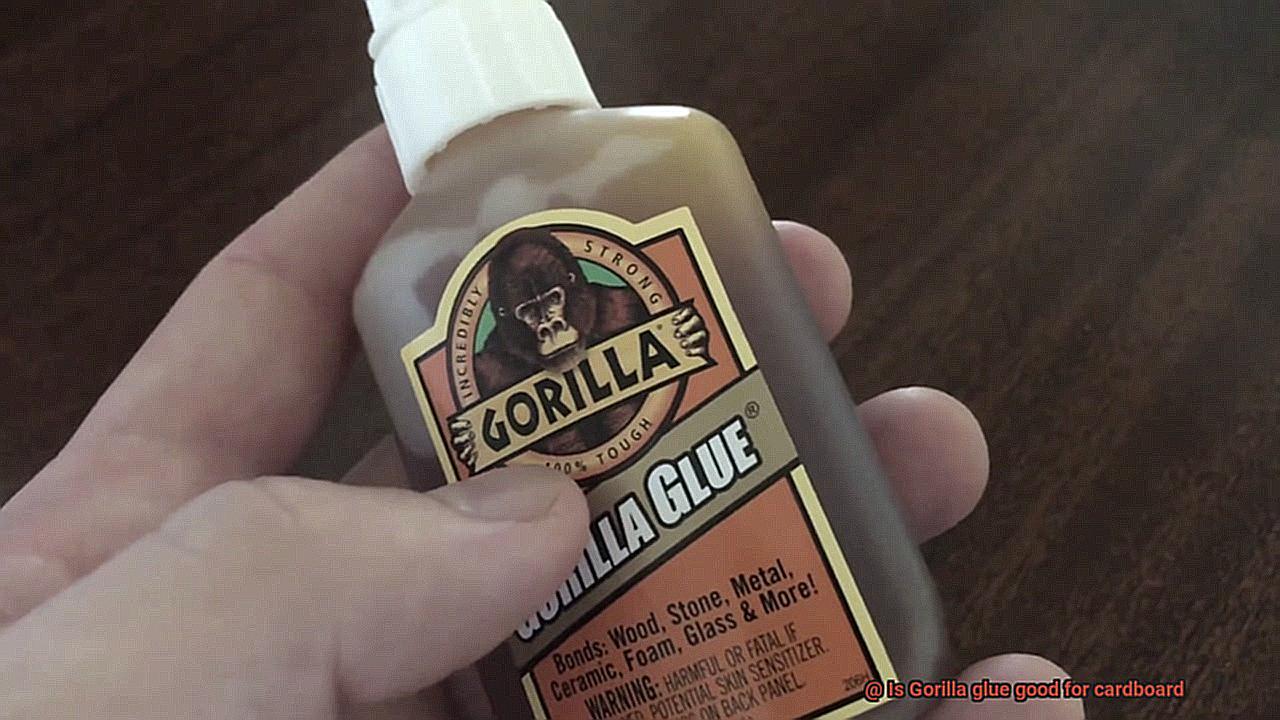
Overall, cardboard is highly useful due to its affordability, ease of use, and recyclability. It is commonly used in packaging, shipping, storage, and creative projects. When it comes to bonding cardboard with glue, caution must be exercised. While Gorilla Glue can be effective on thick or sturdy cardboard projects if applied carefully, its expanding nature and moisture absorption can potentially warp or weaken lightweight cardboard. Therefore, it is recommended to choose an appropriate adhesive based on the specific requirements of the project.
How Does Gorilla Glue Bond with Cardboard?
Gorilla Glue, a popular adhesive known for its strong bond and versatility, forms a robust connection with cardboard through a combination of its unique chemical composition, curing process, and expansion characteristics. The glue’s chemical composition plays a significant role in its adhesive properties. Made up of polyurethane, a polymer known for its strong bonding capabilities, Gorilla Glue establishes a powerful bond with various surfaces, including cardboard.
The curing process is another crucial aspect of Gorilla Glue’s bonding mechanism. Upon contact with moisture, the glue undergoes a chemical reaction called curing. This process is vital for creating a durable bond between the glue and the surface it is applied to. Cardboard, being a porous material that readily absorbs moisture, provides an ideal surface for the glue to bond with effectively.
As Gorilla Glue seeps into the pores of the cardboard during application, it creates a strong interlocking bond. The glue fills any gaps or irregularities in the cardboard surface, further enhancing the bond strength and creating a seamless connection between the glue and the cardboard.
Furthermore, Gorilla Glue expands as it cures, which contributes to its exceptional bond strength. The expansion allows the glue to fill any gaps or spaces between the layers of cardboard, ensuring a tight and secure bond. This expansion characteristic is especially useful when working with uneven or textured cardboard surfaces.
The curing time for Gorilla Glue can vary depending on factors such as temperature and humidity. Generally, it takes about 24 hours for the glue to fully cure and reach its maximum bonding strength. During this time, it is crucial to clamp or hold the glued parts together to maintain pressure on the bond and ensure optimal adhesion.
Once fully cured, Gorilla Glue becomes water-resistant, making it even more suitable for bonding cardboard. This feature adds an extra layer of protection to the bonded surfaces, making them more resistant to moisture damage caused by light water splashes or humidity.
To ensure a successful bond between Gorilla Glue and cardboard, it is essential to clean the cardboard surface thoroughly before applying the glue. Removing any dirt, dust, or grease from the surface will improve the adhesive’s effectiveness. Additionally, it is crucial to apply Gorilla Glue sparingly when working with cardboard to prevent warping or bulging of the material.
Different Types of Gorilla Glue and Their Suitability for Cardboard
Gorilla Glue is a popular brand of adhesive known for its strength and versatility. It offers a range of different types of glue, each with its own unique characteristics and suitability for various materials. When it comes to bonding cardboard, it is important to consider the specific type of Gorilla Glue that will provide the best results.
One of the most well-known types of Gorilla Glue is the original Gorilla Glue. It is known for its incredible strength and ability to bond a wide range of materials, including wood, metal, stone, ceramics, and some plastics. However, when it comes to cardboard, the original Gorilla Glue may not be the best choice. Its expanding nature can create a foamy texture that may not be suitable for lightweight materials like cardboard. Additionally, the foaming action can make the application messy and challenging to achieve a clean bond.
Another type of Gorilla Glue that may be more suitable for bonding cardboard is Gorilla Wood Glue. This glue is specially formulated for wood projects but can also be used on porous materials like cardboard. It provides a strong bond and dries clear, making it ideal for projects where appearance matters. While Gorilla Wood Glue can work well on some types of cardboard, it may not adhere as effectively to smooth or coated surfaces.
For projects that require bonding cardboard, Gorilla Clear Glue can be a good option. This transparent adhesive is designed for bonding different materials, including glass, plastic, and fabric. It offers a strong bond and dries clear, making it ideal for projects where aesthetics are important. When it comes to cardboard, this glue adheres well to different types of surfaces without causing warping or damage.
It is also worth mentioning Gorilla Tape when discussing Gorilla products suitable for cardboard. Although not technically a glue, this heavy-duty tape is known for its strong adhesive strength and durability. It can be used to bond cardboard together or reinforce weak areas. However, it is important to note that Gorilla Tape may leave a sticky residue on the cardboard surface when removed.
Preparing the Surface for Gorilla Glue Application on Cardboard
When it comes to preparing the surface for Gorilla Glue application on cardboard, following the proper steps is crucial to ensure a strong and durable bond. Let’s dive into the preparation process, step by step:
- Clean the surface: Before applying Gorilla Glue, take a moment to wipe down the cardboard surface using a damp cloth or sponge. This simple step removes any dirt, dust, or grease that could hinder the glue’s adhesion.
- Smooth out rough edges: If you notice any rough edges or uneven surfaces on the cardboard, lightly sand them. This helps create a smoother surface for the glue to adhere to, resulting in a stronger bond.
- Ensure dryness: Before applying Gorilla Glue, it’s important to make sure the cardboard is completely dry. Any moisture present on the surface can interfere with the adhesive properties of the glue. Allow the cardboard to air dry thoroughly before proceeding.
- Consider reinforcement: Depending on your project’s requirements, you may want to reinforce the cardboard before applying Gorilla Glue. This can be done by adding additional layers of cardboard or using a backing material like plywood. Reinforcing the cardboard provides extra stability and prevents flexing or bending that may weaken the bond.
- Apply Gorilla Glue: Now it’s time to apply the Gorilla Glue. Squeeze a small amount of glue onto one of the surfaces you want to bond together. Remember that Gorilla Glue expands as it cures, so only a thin layer is necessary for a strong bond.
- Spread evenly: Use a brush or spreader to evenly distribute the glue over the entire surface that will come into contact with the other surface. Make sure to cover all areas thoroughly.
- Join surfaces and apply pressure: After applying the glue, join the two surfaces together and apply pressure. If needed, use clamps or weights to ensure a tight bond. Hold the surfaces in place for at least 1-2 hours while the glue cures.
- Allow curing time: It is recommended to let the glued cardboard cure for at least 24 hours before handling or putting any stress on the bond. This gives the glue sufficient time to fully set and strengthen the bond.
- Consider additional measures: Depending on your project’s requirements, you may want to consider using tape or applying a protective coating over the glued area to reinforce the bond further.

Using Gorilla Glue on Cardboard
Gorilla Glue is a well-known adhesive that is loved for its strong bonding properties. But can it be used on cardboard? This question often arises among DIY enthusiasts and hobbyists. In this article, we will explore the process of using Gorilla Glue on cardboard, providing important considerations and tips to achieve the best results.
- Understanding Gorilla Glue: Gorilla Glue, especially the original formula, is a polyurethane adhesive that expands and forms a powerful bond when it comes into contact with moisture. It is designed to bond various materials, such as wood, metal, stone, ceramics, and more.
- Consider the Application: Before using Gorilla Glue on cardboard, it’s crucial to consider the specific application and purpose. If you need a permanent bond between two pieces of cardboard, Gorilla Glue can be an effective choice. However, for temporary or non-permanent applications, alternative adhesives may be more suitable.
- Prepare the Surface: To ensure proper adhesion, clean the surfaces of the cardboard thoroughly by wiping them with a damp cloth or using a gentle cleaning solution if necessary. Additionally, roughening the surface slightly with sandpaper can improve adhesion.
- Apply with Caution: When applying Gorilla Glue on cardboard, caution is required due to its expansion properties. The glue expands as it cures, so it’s essential to apply a thin layer to prevent excess oozing. Excess glue can seep into the cardboard fibers and weaken its structure. Use a small amount of glue and spread it evenly using a brush or applicator.
- Secure and Allow Drying Time: Once you have applied the Gorilla Glue, firmly press the pieces of cardboard together and secure them in place with clamps or heavy objects. Allow sufficient drying time for the glue to cure completely. The drying time may vary depending on factors like temperature and humidity, so it’s advisable to refer to the manufacturer’s instructions for specific guidelines.
- Beware of Warping: It’s important to note that Gorilla Glue may cause slight warping or distortion of the cardboard during the drying process because of its expansion properties. Therefore, consider this factor when using the glue on delicate or precision cardboard projects.
- Consider Alternatives: For temporary or non-permanent applications on cardboard, such as attaching lightweight decorations or labels, alternative adhesives may be more appropriate. Double-sided tape, glue sticks, or other craft adhesives specifically designed for paper and cardboard materials can provide a strong enough bond without damaging or distorting the cardboard.
Potential Expansion of Gorilla Glue When Used on Cardboard
While it is commonly used on various materials like wood, metal, and ceramics, using Gorilla Glue on cardboard requires some caution to avoid potential issues.
One potential problem with using Gorilla Glue on cardboard is its tendency to expand as it cures. As a polyurethane-based adhesive, Gorilla Glue reacts with moisture to create a strong bond. During the curing process, the glue can expand and exert pressure on the surrounding materials.
Cardboard, being a porous material that absorbs moisture easily, is particularly susceptible to this expansion. When Gorilla Glue is applied to cardboard, the moisture in the glue can be absorbed by the cardboard, causing it to expand. Consequently, this expansion can lead to warping, buckling, or even tearing of the cardboard.
To mitigate excessive expansion and preserve the structural integrity of your cardboard project, there are several precautions you can take:
- Apply a thin layer: Instead of slathering on a thick coat of Gorilla Glue, opt for a thin layer. This reduces the amount of moisture absorbed by the cardboard and limits expansion.
- Lightly moisten the surface: Before applying the glue, gently moisten the surface of the cardboard with a damp cloth or sponge. This helps control moisture absorption and minimizes expansion.
- Use clamps or weights: Once you have applied the glue and positioned the pieces of cardboard together, secure them firmly using clamps or weights while the glue cures. This prevents any shifting or movement that could contribute to further expansion.
- Consider alternative adhesives: If you are working with delicate or thin cardboard, it may be prudent to explore alternative adhesive options specifically designed for paper or lightweight materials. These adhesives typically have a lower expansion rate and are less likely to cause damage to the cardboard.
Testing the Adhesive Before Applying to the Entire Project
Testing the adhesive before applying it to the entire cardboard project is crucial for several reasons. It allows you to ensure a strong bond, assess compatibility, evaluate drying time, prevent mishaps, consider specific project requirements, and ensure safety.
Firstly, testing the adhesive helps determine its bond strength. By applying a small amount of adhesive to a separate piece of cardboard, you can evaluate how securely it holds the materials together. This ensures that the adhesive will be strong enough to securely hold all parts of your project.
Secondly, testing allows you to assess compatibility. Different adhesives may react differently with cardboard materials. By testing on a small portion of the cardboard, you can see how well the adhesive adheres to the specific type of cardboard you are using. This ensures that the adhesive is compatible with your project and will provide a strong bond.
Thirdly, testing helps evaluate drying time. Knowing how long it takes for the adhesive to dry and cure completely is crucial for planning your project timeline and avoiding any potential damage or disruption during the drying process.
Furthermore, testing allows you to identify any potential issues or challenges that may arise. This gives you an opportunity to make adjustments or choose a different adhesive if necessary, preventing any mishaps or damage to your final project.
Additionally, testing allows you to consider specific project requirements. Not all adhesives are suitable for every type of project. By testing the adhesive, you can assess whether it meets the specific requirements of your project, such as load-bearing capacity or resistance to moisture.
Lastly, testing the adhesive ensures safety. It gives you an opportunity to consider any safety concerns associated with its use. You can ensure proper ventilation and follow all safety instructions provided by the manufacturer.
Conclusion
When it comes to bonding cardboard, Gorilla glue is a reliable choice. Its strong adhesive properties make it ideal for securing pieces of cardboard together. Whether you’re working on a craft project or repairing a cardboard box, Gorilla glue can provide the strength and durability you need.
Not only does Gorilla glue create a solid bond, but it also dries clear, ensuring that your finished project looks seamless and professional. You won’t have to worry about unsightly glue marks ruining the appearance of your cardboard creation.
One of the standout features of Gorilla glue is its versatility. It can be used on various types of cardboard, including corrugated cardboard and cardstock. No matter the thickness or texture of your cardboard material, Gorilla glue will effectively adhere to it.
Furthermore, Gorilla glue is waterproof once fully cured. This means that if your cardboard creation gets exposed to moisture or humidity, the bond will remain intact. You can have peace of mind knowing that your glued cardboard items will stay securely in place even in less-than-ideal conditions.
In addition to its impressive adhesive capabilities, Gorilla glue is also easy to use. Its thick consistency allows for precise application without excessive dripping or messiness. Simply apply a thin layer of the glue onto the desired areas of your cardboard, press them together firmly, and let the adhesive work its magic.
However, like any other adhesive product, there are some precautions to keep in mind when using Gorilla glue on cardboard. It’s important to ensure that both surfaces are clean and free from dust or debris before applying the glue. Additionally, allow sufficient drying time for the adhesive to fully cure for optimal results.
In conclusion, when it comes to bonding cardboard, Gorilla glue is an excellent choice. Its strong adhesive properties combined with its versatility and ease of use make it a reliable option for all your cardboard projects.

